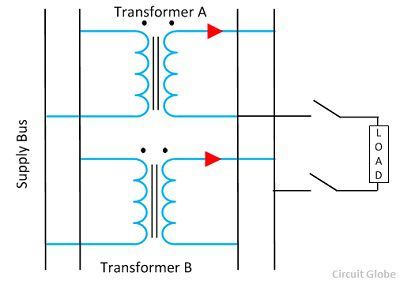The Transformer is said to be in Parallel Operation when its primary winding is connected to a common voltage supply, and the secondary winding is connected to a common load.
The connection diagram of the parallel operation of a transformer is shown in the figure below.
The parallel operation of a transformer has some advantages likes it increases the efficiency of the system, makes the system more flexible and reliable. But it increases the short-circuit current of the transformers.
Contents:
Reasons For Parallel Operation
Parallel operation of a transformer is necessary because of the following reasons are given below:
- It is impractical and uneconomical to have a single large transformer for heavy and large loads. Hence, it will be a wise decision to connect a number of transformers in parallel.
- In substations, the total load required may be supplied by an appropriate number of the transformer of standard size. As a result, this reduces the spare capacity of the substation.
- If the transformers are connected in parallel, so there will be scope in future, for expansion of a substation to supply a load beyond the capacity of the transformer already installed.
- If there will be any breakdown of a transformer in a system of transformers connected in parallel, there will be no interruption of power supply, for essential services.
- If any of the transformer from the system is taken out of service for its maintenance and inspection, the continuity of the supply will not get disturbed.
Necessary Conditions For Parallel Operation
For the satisfactory parallel operation of the transformer, the two main conditions are necessary. One is that the Polarities of the transformers must be the same. Another condition is that the Turn Ratio of the transformer should be equal.
The other two desirable conditions are as follows:-
- The voltage at full load across the transformer internal impedance should be equal.
- The ratio of their winding resistances to reactances should be equal for both the transformers. This condition ensures that both transformers operate at the same power factor, thus sharing their active power and reactive volt-amperes according to their ratings.
This is all about the parallel operation of the transformer.


what will happen if there’s small difference in reactance or turn ratio?
Because in practical it couldn’t be 100% same.
then transformer with less reactance will carry more load compared to rating of that transformer & cause overload on that transformer
we want to do one 8 MVA and one 5 MVA ptr’s parallel operation with mild changes in impedance…..what are the results of the effect? please give one example with calculations.
1.what are the loads on both the transformers?
2.if maximum loads taken on the both transformers…what will happen give examples.
we want to do one 8 MVA and one 5 MVA ptr’s parallel operation with mild changes in impedance…..what are the results of the effect? please give one example with calculations.
HV side:-33 kv
LV side:-11kv
1.what are the loads on both the transformers?
2.if maximum loads taken of the both transformers…what will happen give examples
Turns ratio of all transformer must be same for parallel operation otherwise a circulating currents will flow.
It’s informative and educative.
small differance in turns or voltage ratio may be permitted if unavoidable
Is both 1-phase and 3-phase transformer can connect in the parallel connection?
In case of two transformers to be connected for parallel operation, one transformer designed with linear type OLTC and second Transformer designed with reversing type OLTC. Is it feasible ? Thanks in advance for help.